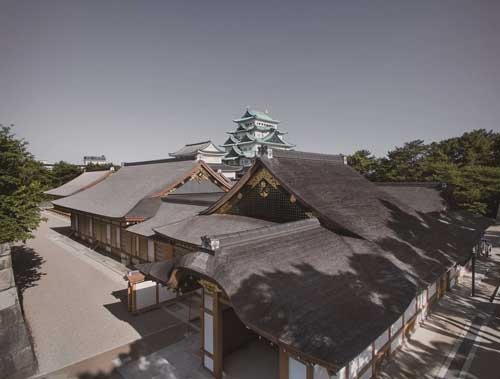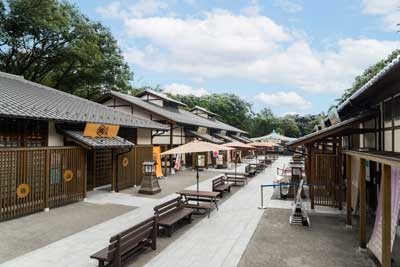2023.01.04
From 4 January 2023, Shiyakusho Station on the Subway Meijo Line will be renamed Nagoyajo (Nagoya Castle) Station, a name that will better reflect its status as a gateway to Nagoya's most famous attraction. This issue, we take a brief look at some things to look out for when you visit Nagoya Castle and the surrounding area.
Special Historical Site, Nagoya Castle (特別史跡 名古屋城)

Photo courtesy of Nagoya Castle
The Ni-no-maru area of the Nagoya (名古屋) Castle grounds was the site of an earlier Nagoya (那古野) Castle, a fortification which is thought to have been constructed between 1521 and 1524 by a branch of the Imagawa clan which had dominion over the northern Nagoya plain since the late Kamakura period.
Amid the strife that followed the fall of the Muromachi shogunate, Oda Nobuhide emerged from the Oda clan that had come to govern Owari, and seized Nagoya Castle from the brother of Imagawa Yoshimoto around 1538. When Nobuhide relocated to Furuwatari Castle (in modern-day Naka Ward) in 1546, he left Nagoya Castle to his son, Nobunaga.
Nobunaga moved to what was then the center of Owari, Kiyosu Castle, in 1555, and his uncle Nobumitsu became lord of Nagoya Castle, followed by vassal Hayashi Hidesada upon Nobumitsu's death. The castle was eventually abandoned, however, in 1582.
In 1600, Tokugawa forces defeated the Toyotomi armies at the Battle of Sekigahara, resulting in the unification of Japan under the authority of Tokugawa Ieyasu. Yet Ieyasu remained wary of the threat posed by Hideyori, son of Toyotomi Hideyoshi, in Osaka, and, anticipating further conflict, placed great importance on Owari and its potential role in the defense of the Tokaido route joining Osaka with Edo (Tokyo), hence the need for a huge military fortress in Owari.
20 western daimyo who had supported the Toyotomi clan, including Kato Kiyomasa and Fukushima Masanori. were tasked by Ieyasu with the castle's construction, which began in 1610.
The enormous keep, crowned with golden shachihoko tiger-fish ornaments, the lavish Hommaru Palace, the extensive Ni-no-maru Garden, the high stone walls and deep moats, and the robust and ingenious fortifications make Nagoya Castle not only a reflection of Tokugawa prestige, but also the ultimate example of early modern castle design.
Throughout the 260 years of the Edo period, Nagoya Castle flourished as the residence of the Owari Tokugawa clan, the chief of the three branches of the Tokugawa. The town of Kiyosu was relocated to the area around Nagoya Castle as it was constructed, and the castle town arranged on the grid-like layout with which residents of Nagoya today are familiar.
Following the Meiji Restoration, the main keep and Hommaru Palace faced the threat of demolition as the castle fell under the jurisdiction of the army and new military facilities were constructed. When it was eventually decided to protect the castle as one of the country's foremost examples of castle architecture, it came under the purview of the Department of the Imperial Household from 1893 as the Nagoya rikyū (離宮, detached palace) to accommodate the Emperor and members of the imperial family.
Bestowed upon the City of Nagoya in 1930, the main keep, Hommaru Palace and other buildings became the first castle structure to be designated a National Treasure. Nagoya Castle, with the north section of Meijo Park, was opened to the public in 1931, and became a familiar symbol of the city.
On the morning of 14 May 1945, air raid sirens rang out as American B29 bombers dropped countless incendiary bombs over the northern part of Nagoya, transforming the city into a sea of fire in a raid that lasted over an hour. An incendiary bomblet caught on scaffolding erected to move the golden shachihoko to safety, the rising flames soon turning the whole castle into a fireball, destroying the main structures including the keep and the Hommaru Palace.
Although only the stone walls remained, the site was opened to the public once again in 1946. The remaining structures and the painted wall screens of the Hommaru Palace were designated Important Cultural Properties.
In response to the growing call from citizens to rebuild the castle, the Nagoya Castle Reconstruction Preparatory Committee was established by the city in 1955. Donations to the reconstruction fund came not only from citizens, but from all over Japan and even abroad. Thus, work to rebuild the main tower keep, the sub tower keep, and the main gate in steel-framed reinforced concrete began in 1957, and was completed in 1959 to coincide with the commemoration of the 70th anniversary of Nagoya City government. (The main keep is currently closed due to age and earthquake resistance concerns.)
Work to reconstruct the Hommaru Palace began in 2009. Although the building itself was lost during the war, the original wall paintings and other artistic artifacts, pre-war era photographs, a detailed survey of the building and other records remained, making a faithful reconstruction possible. The work of skilled craftsmen resulted in an authentic restoration from the pillars, roof, and wall paintings down to the detailed decorations. Opened in three stages as work on each section was completed, the fully reconstructed Hommaru Palace opened in 2018.
As a prominent example of castle construction, Nagoya Castle is a designated national Special Historic Site.
Nishinomaru Okura Johokan (西の丸御蔵城宝館)

Photo courtesy of Nagoya Castle
Located in the Nishinomaru section of Nagoya Castle where a number of rice storehouses previously stood, the Nishinomaru Okura Johokan is an exhibition and storage facility that recreates the exterior of the No. 3 and 4 kura (蔵 / storehouse). The name 'Jōhōkan' (城宝館, lit. castle treasure hall) reflects the facility's purpose as a space for the display of the treasures of the castle, as well as for the sharing of information (情報 / jōhō) about Nagoya Castle.
Visitors to Nagoya Castle can enjoy discovering more about the castle's history and appeal through the History Information Room, and exhibits of treasures including the wall and screen paintings of the original Hommaru Palace (designated National Important Cultural Assets) in the Exhibition Room.
When: 9:00 - 16:00 (Nagoya Castle hours: 9:00 - 16:30)
Admission: Free with admission to Nagoya Castle (see below).
When: 9:00 - 16:30 (Last entry to Hommaru Palace and Nishinomaru Okura Johokan 16:00.) Closed 29 Dec. to 1 Jan.
Where: Nagoya Castle (名古屋城), Naka Ward (中区)
Access: A short walk from Nagoyajo (Nagoya Castle) Sta. ( 「名古屋城(市役所・県庁)」駅, M07) on the Subway Meijo Line (地下鉄名城線)
Admission: Adults 500 Yen; Residents of Nagoya City aged 65 and over 100 Yen; Junior HS students and younger free.
Website: https://www.nagoyajo.city.nagoya.jp/
Kinshachi Yokocho (金シャチ横丁)
A collection of eateries and retail shops divided into two areas, the Yoshinao Zone (義直ゾーン, near the Main Gate of Nagoya Castle) and the Muneharu Zone (宗春ゾーン, near the East Gate), this is a great spot to try some of the flavors of Nagoya that you can add to your Nagoya Castle itinerary.
Yoshinao Zone (Main Gate)

Photo courtesy of Kinshachi Yokocho
Named for the first head of the Owari Domain, Tokugawa Yoshinao (徳川義直), who adhered to the instruction of his father Ieyasu and governed earnestly, the Yoshinao Zone features Nagoya-meshi (Nagoya cuisine) staples from well-established shops in a traditional Japanese-style structure constructed from Japanese cypress.
When: Hours vary; see website for current opening times for each store.
Access: A 10-minute walk from either Nagoyajo (Nagoya Castle) Sta. ( 「名古屋城(市役所・県庁)」駅, M07) Exit 7 on the Subway Meijo Line (地下鉄名城線) or Sengen-cho Sta. ( 「浅間町」駅, T05) Exit 1 on the Subway Tsurumai Line (地下鉄鶴舞線).
Muneharu Zone (East Gate)

Photo courtesy of Kinshachi Yokocho
Named for the seventh head of the Owari Domain, Tokugawa Muneharu (徳川宗春), a political innovator who developed Nagoya into a vibrant city, the Muneharu Zone is a collection of shops generating a new culinary culture in Nagoya, housed in an open, glass-sided modern Japanese-style structure.
When: Hours vary; see website for current opening times for each store.
Access: A short walk from Nagoyajo (Nagoya Castle) Sta. ( 「名古屋城(市役所・県庁)」駅, M07) Exit 7 on the Subway Meijo Line.
Website: http://kinshachi-y.jp/index.html (Japanese)
Meijo Park (名城公園)

Meijo Park is a general park spanning 80-hectares. As one might assume from the name (Meijo [名城] being a shortened term for Nagoya-jo [名古屋城], or Nagoya Castle), Nagoya Castle is the centrepiece of the park.
The North Park, surrounded by a wooded area, features a Lawn Plaza complete with bubbling brook, the Ofuke Pond (a remnant of the Edo period), a wisteria corridor and other seasonal attractions to enhance an enjoyable stroll at any time of the year. With a baseball ground, tennis courts and other sporting facilities, it's also a popular spot for residents to enjoy a variety of sporting activities.
At the Meijo Park Flower Plaza, located on the east side of the North Park, residents can get advice on taking care of flowers and plants, browse related materials, and attend a variety of classes, events and exhibits held there.
When: Meijo Park Flower Plaza - 9:00 - 16:30. Closed Mondays (or the following day if Monday is a national holiday), the 3rd Wednesday of the month (or the 4th Wednesday if the 3rd Wednesday is a national holiday), 29 Dec. to 3 Jan.
Where: Meijo Park North Park (名城公園北園), Kita Ward (北区)
Access: A 3-minute walk from Meijo Koen Sta. ( 「名城公園」駅, M08) Exit 2 on the Subway Meijo Line (地下鉄名城線).
Website: Meijo Koen / Meijo Koen Flower Plaza - http://www.meijyo-fp.com/index.html (Japanese)
Nagoya City Hall Main Building (名古屋市役所本庁舎)

The current main building, the third building to serve as the Nagoya City Hall, was constructed as a project to commemorate the accession of the Emperor Showa (Hirohito), and was completed in 1933.
The building's exterior is 'early modern based on Japanese tastes', and features a Japanese-style tiled roof atop a modern building. The design, by architect Hirabayashi Kingō, of Toyoyama village, Nishikasugai district (now Toyoyama Town), was selected from among 559 submissions from the general public.
A unique characteristic of the exterior design is the 53.5-meter clock tower in the center of the building. The tower's double roof is adorned with four shachi (mythical tiger-fish creatures) watching over all directions, an element incorporated to give the building harmony with Nagoya Castle. Hirabayashi was most particular about the clock tower with shachi ornaments to emphasize the character of Nagoya, an aspect which was highly regarded during the selection process for the exterior design.
The scale of the building was large for a municipal government building at the time. The creative exterior design, with walls covered in specially-made tiles, together with the skillful interweaving of traditional design in the interior, make this piece of western architecture with Japanese elements a celebrated example of early Showa-era government building design. In December 2014, the Nagoya City Hall Main Building, along with the adjoining Aichi Prefectural Office Main Building, was designated a national Important Cultural Property.
When: Weekdays (except national holidays)
Where: Nagoya City Hall Main Building (名古屋市役所本庁舎), Naka Ward (中区) public access areas including corridors, stairs
Access: A 1-minute walk from Nagoyajo Sta. ( 「名古屋城」駅, M07) on the Subway Meijo Line (地下鉄名城線), or a 5-minute walk from Higashi Ōte Sta. 「( 東大手」駅, ST02) on the Meitetsu Seto Line (名鉄瀬戸線).
Website: https://www.city.nagoya.jp/index.html




